An easy, step-by-step whole wheat sourdough bread recipe and video that’s light and flavorful (not heavy and dense). Made with 20% whole wheat flour. Naturally leavened with active sourdough starter. Excellent for sandwiches, toast and soup.
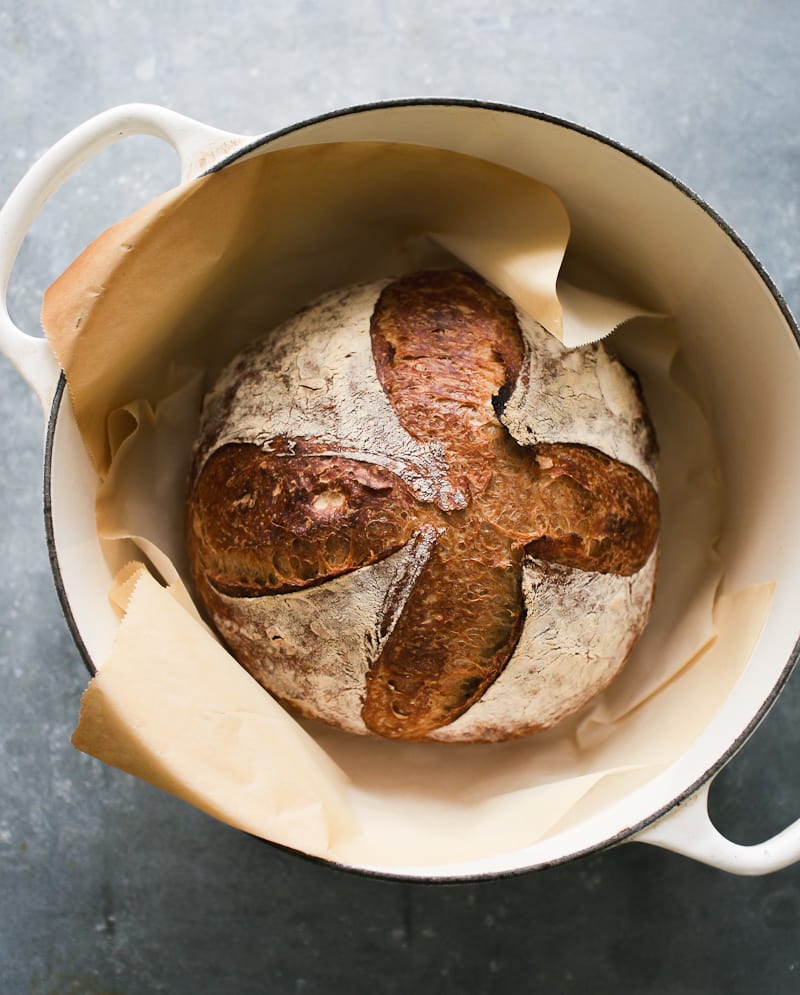
Whole grain flours are prized for their toasty, earthy flavors. Packed with plenty of fiber and nutrients, their natural complexity is a perfect match for slow-fermented sourdough bread. However, in bread baking there are rules…
You can’t just swap white flour for whole wheat flour and expect the same results (unless you like dry and dense bread). Adjustments need to be made. In this post, you’ll learn how to make exceptional whole wheat sourdough bread that’s not only light and delicious, but good for you too.
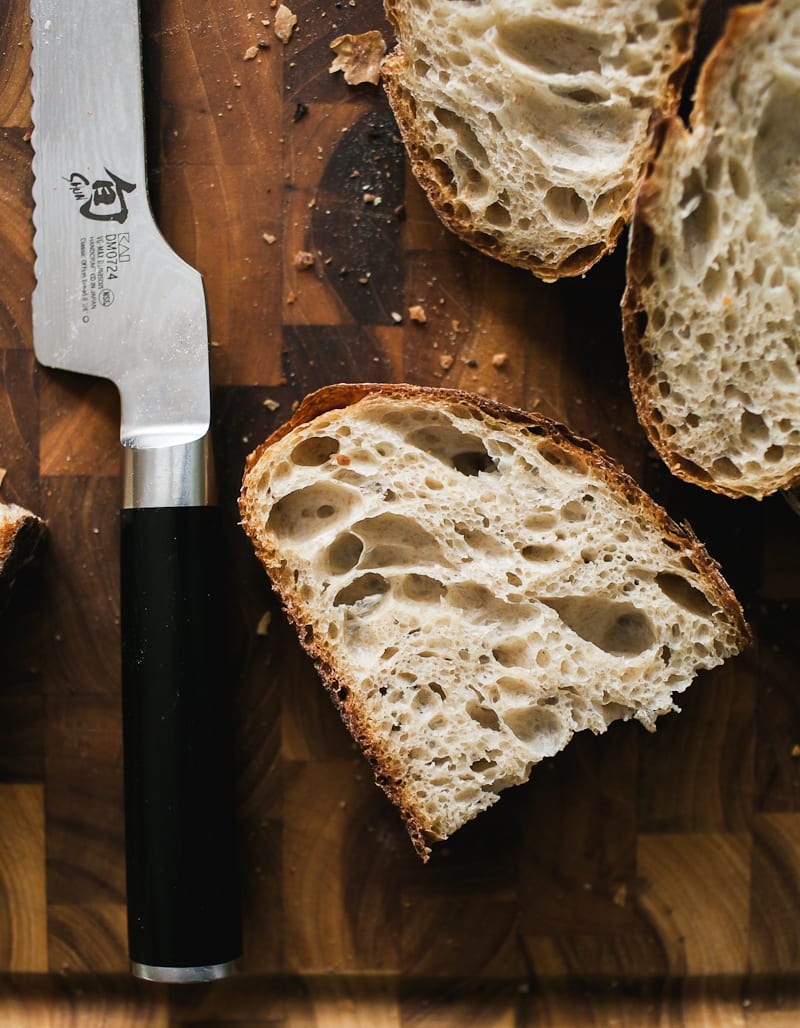
How to Make Whole Wheat Sourdough Bread
Mix The Dough
Weigh your ingredients using a scale. Mix the starter and water together in a large bowl. Add the flour and salt. Stir to combine and then squish by hand to fully incorporate the ingredients. This dough is very sticky, around 75% hydration. It’s like playing with wet mud (and it’s very satisfying). Cover the bowl and let rest for a 1 hour.
TIP: Whole wheat flour is incredibly thirsty. Because it absorbs more water than regular white flour, extending the “autolyse” or first rest period gives this dough ample time to hydrate. You’ll notice a huge difference after the full hour. The dough will be incredibly soft, and easy to stretch and fold later on.
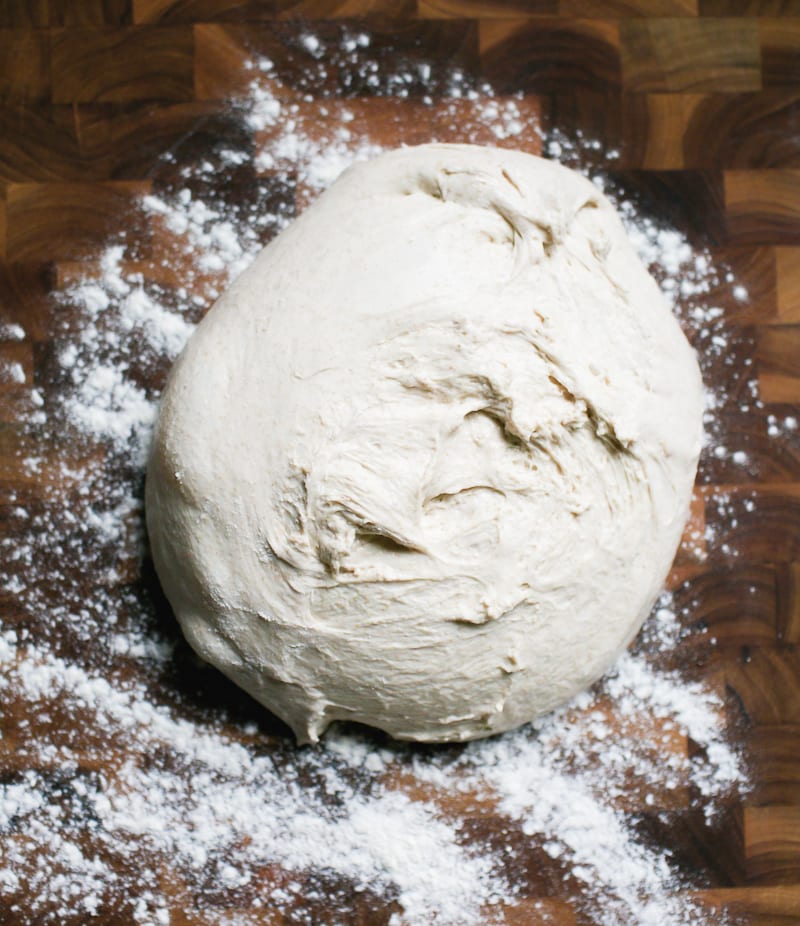
Bulk Rise with Stretch & Folds
Now, the dough needs to rise.
During this time period, you’ll stretch and fold the dough to boost the height of the bread. I like to do 4 sets spaced 30 minutes apart, resting the dough in a warm spot in between each set. The dough will become soft, pillowy and a bit stiffer by the 4th set which is what you want (don’t forget to watch my video above!).
When finished with the folds…
Cover the bowl and continue the bulk rise, untouched at 75-78 F for about for 2-3 hours. The dough is ready when it has almost doubled in size. Cover the bowl with lightly oiled wrap and chill overnight.
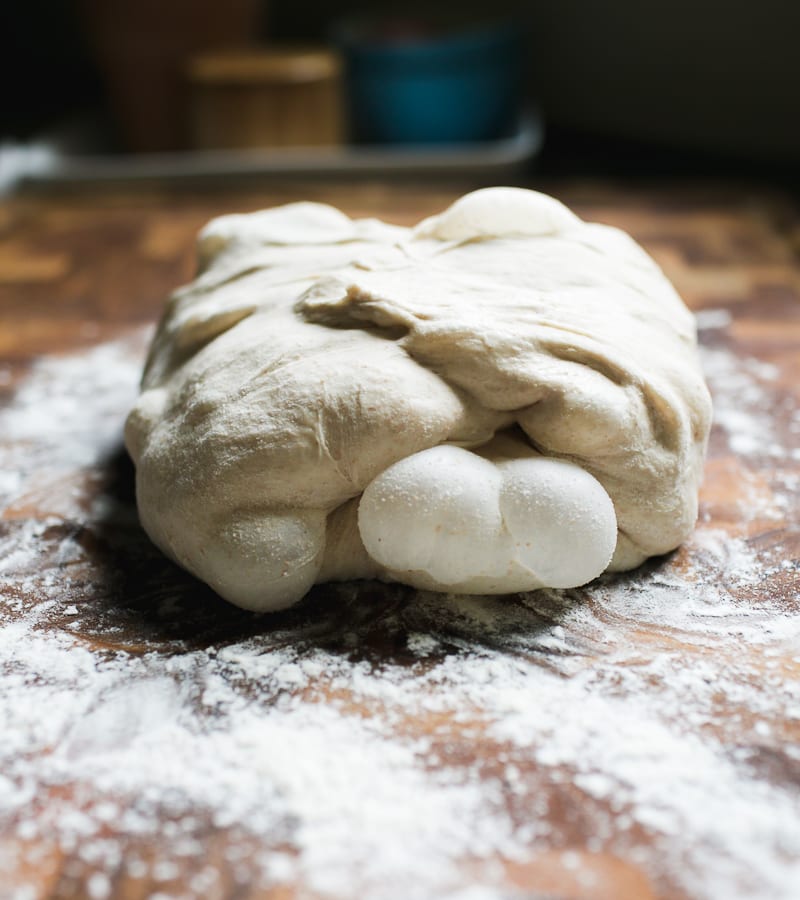
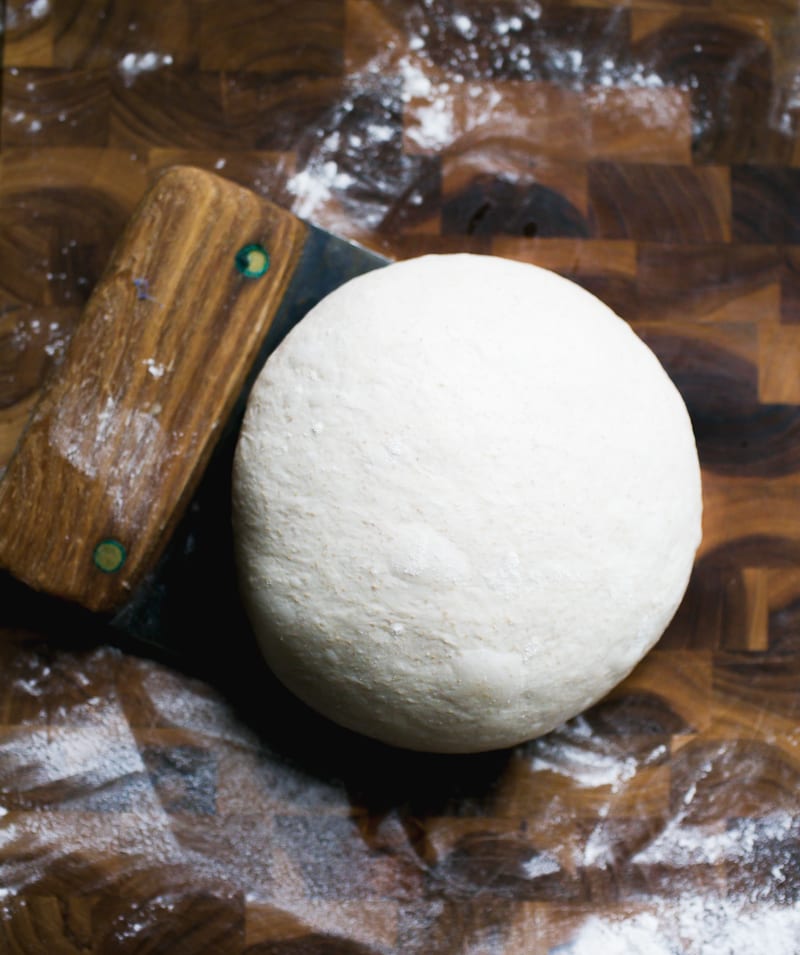
Shape The Dough
The following morning, you’re going to shape the dough twice to build extra strength. The first shaping is called a “preshape” and the second one is the “final shape.”
Preshape
Remove the cold dough onto a floured surface. Rest for 10-15 minutes to take the chill off. Shape the dough into a loose ball; cover and rest for 20-30 minutes.
Final Shape
Using a bench scraper for guidance, flip the dough over and shape it again (a little bit tighter this time). Place into the lined bowl or proofing basket seam side up. Cover the dough with the cloth overhang.
Preshaping Bread Dough: Not every dough needs a preshape. However, wet doughs like this one benefit from the extra support to holds its shape. Otherwise it might spread out a bit.
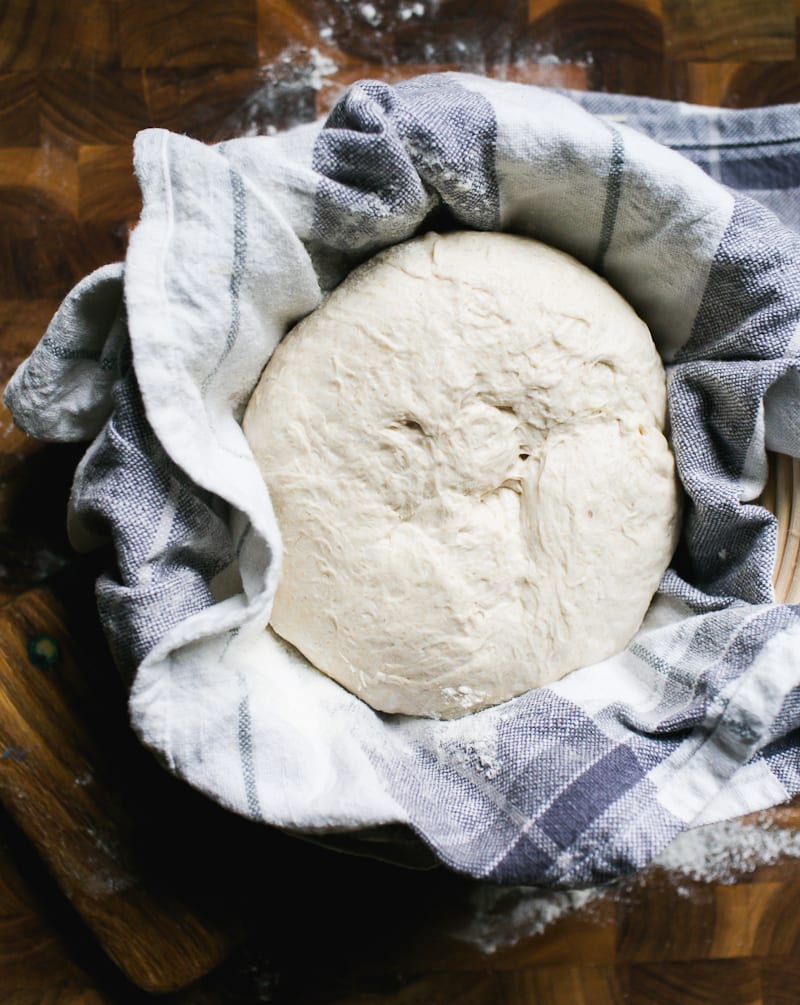
Second Rise
The dough needs to rise again.
Rest the dough in the warm spot you used earlier for about 30 minutes to 1 hour. The dough is ready when it has puffed up and looks plump. It should not be super cold prior to baking.
Preheat the oven to 450 F towards the tail end of the second rise.
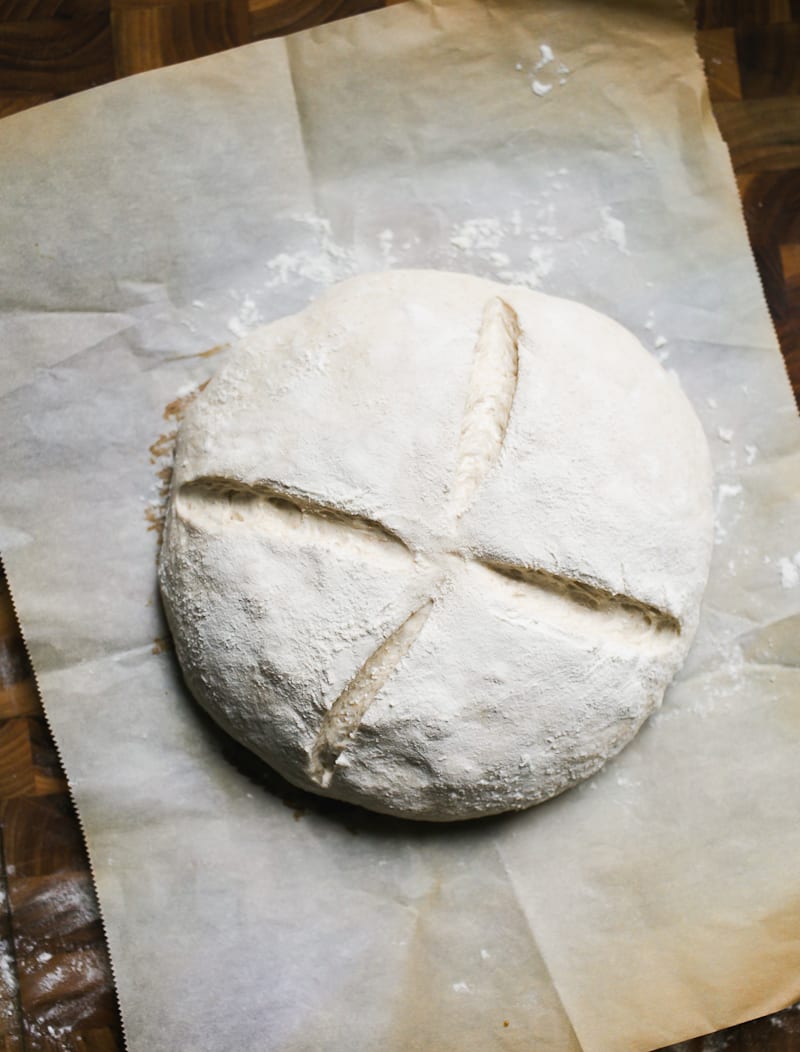
Score The Dough
Using a bread lame or a small serrated knife score the dough at 12, 3, 6 and 9 o’clock, turning the parchment paper as you go. Alternatively, you can make one long slash down the center. Do whatever you feel comfortable with.
Bake The Dough
Bake the dough in a Dutch oven (or another oven safe pot) with the lid on for 20 minutes. Remove the lid and bake for an additional 40 minutes or until golden brown. Remove from the pot. For best texture, cool on a wire rack for 1 hour before slicing
How good does this look?!
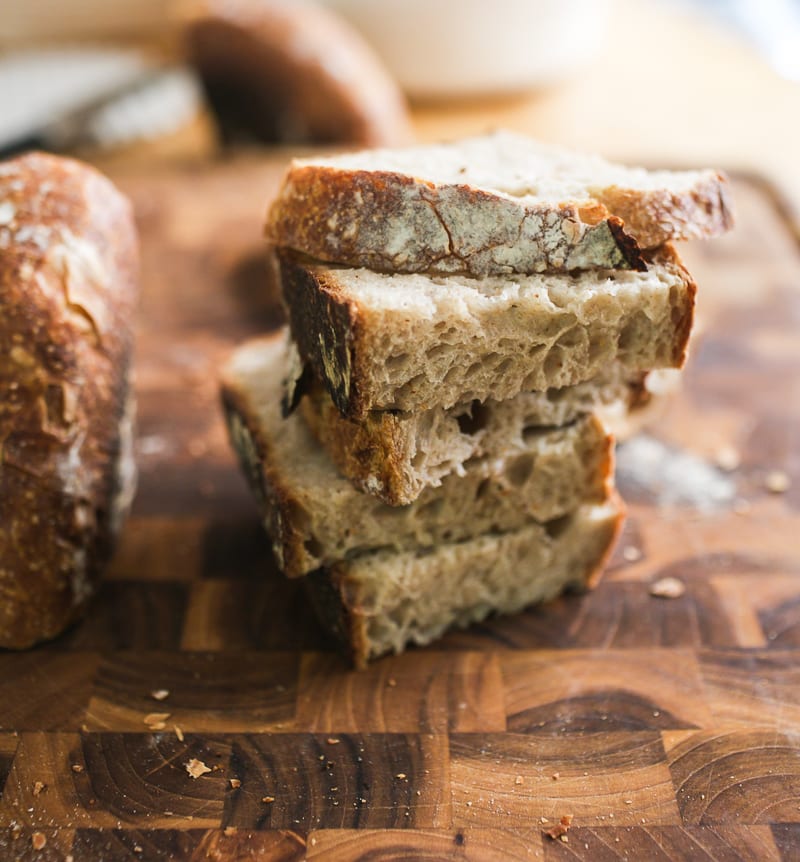
How Does it Taste?
Because this dough is made with 20% whole wheat flour, the flavor is mild and nutty with a beautifully light texture. It’s perfect for those who want the taste of whole wheat without the heaviness.
For a heartier loaf, you can increase the whole wheat up to 30% with additional water (see recipe below). However, I think this particular recipe and method is the perfect starting point. Try it and see for yourself!
Sample Baking Schedule
TIP: Whole wheat doughs tend to rise faster than white doughs, especially in warm weather. To avoid over proofed dough, I like to make this recipe in the afternoon (usually between 2-3 PM) when I know I’ll be home to incorporate the stretch and fold technique. The dough is shaped and baked the following morning.
- 2:00 PM: Mix the dough/Rest for 1 hour
- 3:00 PM: 1st Stretch and Fold
- 3:30 PM: 2nd Stretch and Fold
- 4:00 PM: 3rd Stretch and Fold
- 4:30 PM: 4th Stretch and Fold
- 5:00 PM: Bulk rise for 2-3 hrs @ 75- 78 F
- 7:00 or 8:00 PM: Cover and chill the bowl overnight
- 6:00-8:00 AM (the following morning): Shape & Bake the dough
More Sourdough Bread Recipes to Try!
- Sourdough Bread: A Beginner’s Guide
- Sourdough Focaccia Bread (soft & fluffy!)
- Easy Sourdough Sandwich Bread
- Soft Sourdough Cinnamon Rolls

Light Whole Wheat Sourdough Bread
- Yield: 1 loaf
- Category: Sourdough Bread Recipes
- Method: Oven-Baked
- Cuisine: American
- Diet: Vegan
Description
An easy recipe for whole wheat sourdough bread that’s light and flavorful (not heavy and dense). Made with 20% whole wheat flour. The dough can be made in advance and baked the following day. Fantastic for sandwiches, crostini, and morning toast with jam.
Ingredients
- 50g bubbly, active sourdough starter (100% hydration)
- 350g – 375g warm water (80–85 F)* See note below
- 400g bread flour
- 100g whole wheat flour
- 9g fine sea salt
Notes & Substitutions
* Flour is like a sponge. Depending on the brand you’re using, it might not absorb all of the water. Start with 350g of water if you’re using a low protein bread flour, less than 12.7%.
For best results, use a scale to weigh your ingredients. If using measuring cups, please aerate the flour first, lightly spoon it into the cup, and then level off the excess with the back of a knife.
Instructions
Baking Schedule
Whole whether doughs tend to rise faster than white doughs, especially in warm weather. To avoid over proofed dough, I like to start mixing in the afternoon (usually between 2-3 PM) when I know I’ll be home to stretch and fold the dough. Please adjust your rise times based on temperature.
Make the Dough
Combine the sourdough starter and water in a large bowl. Add the flour and salt. Mix with a fork and then finish by hand to fully incorporate the flour. It will feel very wet and sticky. Cover with a damp towel or wrap and let rest for 1 hour on your countertop, returning to the bowl after the first 30 minutes to work the dough into a rough ball.
Bulk Rise with Stretch and Folds
After the dough has rested for 1 hour, do your first fold.
Gather a portion of the dough, stretch it upward, and fold it over toward the center of the bowl. Give the bowl a 1/4 turn and repeat 3 more times, stretch and folding the dough to come full circle around the bowl (4 folds = 1 set). If the dough still feels slack after the 1st set, do an additional 4 folds around the bowl to tighten the dough.
For best results, do 4 sets total spaced 30 minutes apart resting the covered dough in a warm spot in between each set (see tip below). Notice how the dough will tighten after the 4th set. See video for technique.
When finished with the folds, cover the bowl and continue the bulk rise (untouched) at 75-78 F for about for 2-3 hours. The dough is ready when it has almost doubled in size. Wrap and chill the whole bowl overnight; the dough will continue to rise only slightly in the fridge when the dough is warm.
How to Create Warm Spot for Bread Dough: Preheat your home oven to the lowest setting for 30- 45 seconds and then shut it off. Place the covered bowl of dough inside to bulk up. The temperature should be 75-78 F and no higher than 80 F. Use an oven thermometer (and common sense) to keep track of the temperature. Dough that is too warm will become wet, sticky, and a tricky to work with. Alternatively, I highly recommend using a proofing box.
Shape the Dough
The following morning, make sure the dough has doubled in size. If not, give it more time to bulk up, if needed. This is important to build strength.
Line a small bowl (or proofing basket) with a cotton or linen cloth. Sprinkle with flour. You’re going to shape the dough twice to build extra strength.
Preshape
Remove the cold dough onto a floured surface. Let rest for 10-15 minutes to take some of the chill off. Shape the dough into a loose ball using the envelope technique. Starting at the top of the dough, stretch and fold it over toward the center. Then stretch and fold the bottom of the dough toward the center. Repeat on the left side…and then the right side. Using a bench scraper, scoop up the dough and flip it over so the smooth side is facing up. Cover and rest for 20-30 minutes.
Final Shape
After the dough has rested, flip it over again (the smooth side should be facing down now). Shape it again following the steps above. Flip it back over. With floured hands, gently cup the dough and pull it toward you in a circular motion to tighten its shape. Place the dough into the lined bowl or proofing basket seam side up. Cover with the cloth overhang.
Second Rise
Rest in the warm spot you used earlier for 30 minutes to 1 hour. The dough is ready when it looks puffy and has risen slightly, but has not yet doubled in size. The dough should not be very cold prior to baking.
Preheat your oven to 450 towards the tail end of the second rise.
Cut a sheet of non-stick parchment paper to fit the size of your baking pot, leaving enough excess around the sides to remove the bread.
Score the Dough
Place the parchment over the dough and invert the bowl to release. Sprinkle the dough with flour and gently rub the surface with your hands. Using the tip of a bread lame, small, serrated knife or a razor blade, make four shallow 4-inch long cuts at 3, 6, 9, and 12 o’clock around the dough. Use the parchment paper to transfer the dough to a Dutch oven (or another oven safe pot with lid).
Bake the Dough
Bake the dough on the center rack for 20 minutes, covered. Remove the lid, and continue to bake for 40 minutes and golden brown.
When finished, transfer to a wire rack. Cool for 1 hour before slicing, for best texture.
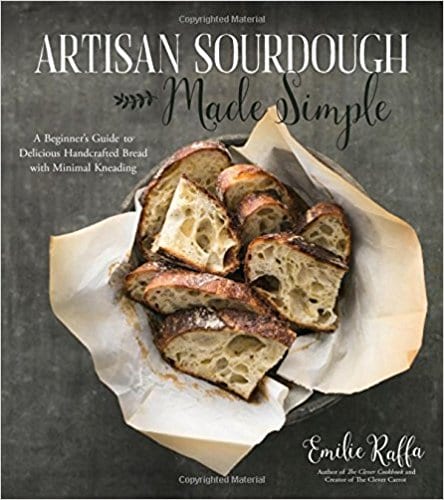


Comments
Noelle says
This recipe is great! I made two loaves at the same time since it was a little time consuming. I forgot to let them rise in a warm spot for the first two hours and they still came out great! Wondering if rye flour would work instead of whole wheat?
Tiffany says
Hi I baked my loaf of sourdough bread and it turned out to be a bit gummy and sticky on the inside, I can’t figure out why :( I followed your recipe with the slight change of bulk rising in room temperature for 6 hours and proofing for one hour and putting it in a 230 Celsius oven for 20+ 40 mins. I cut the bread 4 hrs after baking so it was already cooked when I cut it in. My sourdough starter is also 100% whole wheat flour with water. It’s the second time I’ve made sourdough bread but both times the bread both came out gummy and slightly sticky to touch
Karin says
Is it possible that the recipe is listing the wrong amount of starter? This says 50g, but the white recipe calls for 150gs for the same amount of flour. I assumed the “1” was missing and am giving the recipe a shot with 150!
Emilie Raffa says
Karin, this recipe is correct- only 50 g of starter is used. It’s a completely different recipe & method than the beginner white which calls for 150g.
Karin says
Thanks! Thankfully it actually turned out great with the 150, a bit flat, but still yummy and good texture with some bubbles! I’m glad it wasn’t a lost loaf :)
Ruchi says
Hi.
When and how can we incorporate seeds into the loaf? (I have gathered the courage to go one step further, thanks to the confidence I’ve got in nailing the basic bread thanks to your recipes :) )
Emilie Raffa says
You can add seeds after the first 1 hr rest. Or, during the first or second stretch and fold.
For seeds however, you’ll ned to soak them in warm water first; otherwise they’ll absorb some of the water in the dough making the texture of the loaf a bit dry. Soak the seeds while the dough rests. Drain and pat dry before incorporating into the dough. No need to soak chopped herbs, like rosemary or other “add-in” ingredients.
Jill Nocton-Smith says
A lovely light recipe! Works every time
Emilie Raffa says
Thank you Jill!
Rob says
Hi Emilie, I made your wholewheat sourdough and it turned out absolutely amazing!!! I am doubling the recipe for 2 loafs. Can I ask: 1. When during the process would I split it into the two loaves? 2. Can I follow the exact recipe without any alterations but just splitting the dough? Thanks, Rob
Emilie Raffa says
Fantastic Rob! When doubling the recipe, you’d split the loaves after the bulk rise. Alternatively, you can make two separate bowls of dough if you do not have a container large enough to accommodate the double quantity for the bulk rise. You do not need to make any other changes to the recipe.
Patti says
Hi Emily,
Baked my first round using this recipe and it turned out wonderfully. Now I want to try it in an oval shape. I have a 9 inch banneton oval proofing basket and 4 /12 qt. round and 8 qt. oval Le Creuset Dutch oven. Which size oven should I use?
Thank you!
Emilie Raffa says
This is so great to hear! To bake an oval shaped loaf, I would use the 8 qt. oval Le Creuset. Your round pot might be too small, especially if the dough spreads a bit.
Ambika Agarwal says
Hello Emilie, your recipe and step by step guidance is simply amazing. I was being encouraged to start baking breads with sourdough by a few friends since I baked whole wheat ones occasionally with yeast. I chanced upon your blog while searching and what a chance!! As guided by you I had a starter in 14 days which was oozing out of its jar. Ever since I baked with all purpose flour. One day, after making a starter water mix, I realised I had run out of all purpose flour. I then added 1 cup of whole wheat flour to the 1 cup of all purpose flour. Disgusted with my mistake, I did not read your blog for whole wheat bread but my 1:1 flour bread came out fine (maybe a bit dry and not fluffy). Ever since I have baked as per your proportions and enjoyed the nutty bread. The latest bread was soft and spongy with crispy crust.
Question – What would you suggest I do to have more air spaces in the bread as shown in your blog? Should I vary the proportion of starter/water/ bulk rise time? (I bake with all purpose flour and home grown whole wheat flour, I avoid bread flour as its expensive and I am not too sure of its purity).
Emilie Raffa says
Hi there! Thank you! Ahh… this is the million dollar question. There are so many variables to consider.
Have you tried my sourdough bread with all-purpose flour? Have a look at that post for more details on this.
Ambika Agarwal says
Hi Emilie,
Thank you for your response. I have made the sourdough bread with all purpose flour several times as per your recipe. I was satisfied.
I am hoping for better result with the light whole wheat one. I will be trying it out again tomorrow and will try to be extra careful.
Sanzie says
Hi Emilie, Is there a way I can bulk ferment for 2 hours on the counter and then pre-shape, shape, put in banneton, then do an overnight proof in the fridge, then score and bake the next day? If I can do that, do I stick with the same amount of starter? Thank you!
Emilie Raffa says
Sanzie, unfortunately I haven’t tried it with this recipe. Off the top of my head, if bulking at 68 F it’s not going to work. I’d at least get the temp up to around 78 F for a boost. It won’t rise much in the fridge.
Monica says
Hi, I have tried your sourdough bread recipe (normal flour) and it comes wonderful every time I bake it!! My daughters love it!! Now I am trying this recipe, I am just waiting to do the last 4-set fold but I notice my dough is still very wet, what can I do?
Emilie Raffa says
If the dough seems to wet, I usually only add flour during the initial mixing phase or after the first rest. If you add it afterwards, you run the risk of deflating the dough, but it really just depends on where you’re at in the process. So for you, specifically, if the dough is so wet that you’re unable to handle it, I’d just go ahead and add more flour to at least save it. Good luck!
Hanna says
Hi,
I heard that you can increase the sourness of your bread by refrigerating for a few days. Can I make this recipe and leave it in the fridge for 3 days to deepen the sour taste?
Emilie Raffa says
While chilling the dough helps to deepen the flavor, up to 3 days might be too long- the gluten will begin to break down and the dough might not rise. However, you can always experiment, possibly with a shorter timeframe, and see what happens!
Patti says
Hi Emilie,
I just came across the Clever Carrot and am looking forward to trying your Light Wheat recipe. I have a couple of questions about chilling the dough in the refrigerator after the bulk rise. Do you put the bowl in a plastic bag as some recipes recommend? What’s the maximum amount of time the dough can stay in the refrigerator after the bulk rise before? My work schedule is unpredictable and I wondered if I can put dough in refrigerator early afternoon and still chill overnight to finish and bake the following morning.
Thank you!
Emilie Raffa says
Hi there! For clarification, are you looking to chill the dough for the second rise? As opposed to finishing the bulk rise in the fridge (per the instructions here?). Thanks!
Patti says
Hi Emilie,
I would like to extend the time for finishing the bulk rise in the fridge by about 6 hours so I can start my dough early morning instead of in the afternoon.
Thank you.
Emilie Raffa says
Hi Patti! Thanks for clarifying. Yes: the dough should be fine if you extend the bulk rise by 6 hrs. in the fridge. :)
Patti says
Following your timeline above, I’d like to mix the dough early in the morning , about 7 am, and put it in the refrigerator to finish the bulk rise around noon- 1 pm. That would add about 6 -8 additional hours overnight in the refrigerator.
Thanks!
MS says
I have tried it both ways fridge and overnight rise in the counter. Comes out the same for me. I find for this amount of flour I need 150 to 200g starter and 600g water, maybe it is my scale but that seems to work better for me. 50g of starter is barely a quarter cup and I have always used 1 cup starter and 2 cups water. I do weigh but that seems to work best for me. It is very cold where I am. In the summer I get much better rises. I don’t feed my starter before baking to get extra tang. Been experimenting for a year now and your recipe is heat by far but I need more starter
RC says
I’ve made recipe a few times now and love it. My friends have been so excited to receive loaves since i always double the recipe and share a loaf when I’m baking. I’d like to make a cinnamon raisin sourdough loaf. Have you made or would you be able to offer any information on how I can adapt your soft wheat recipe?
Emilie Raffa says
Hi there! So glad you like it!
For cinnamon raisin, I have a really nice cinnamon raisin swirl sourdough in my book. Or, you can try the Sourdough Cinnamon Raisin Sandwich Bread. And finally, you could also add a cinnamon swirl and/or raisins to this recipe (have a look at the sandwich bread version for reference). Enjoy!
Mat says
How do I prep dough and have it ready later in the week to bake?
Emilie Raffa says
Hi Mat! This technique doesn’t really work with sourdough; it’s best for doughs made with instant yeast.
Alexis says
Hello! Really looking forward to making this. Have been recommended to try your recipes for a long time now. If I don’t own a Dutch oven is there a sufficient alternative for a baking method? I moved out of my parents house and can’t mooch off their Dutch oven anymore ;)
Lynne says
You can use a big aluminium foil tray (those used for big chicken roast) as cover. Put the dough on a baking tray and cover it with the aluminium tray. It traps the moisture and it works!
Emilie Raffa says
Yes! This is a great tip!
Corina says
Hi Emily, thanks for this great recipe and the tips. I was wondering if I could skip the fridge over night. I am home all day and I started at 9am, do you think I can bake it tonight?
I am using a bread proofing box set at 27°C, so hoping the rise will happen with ease even though it quite cold today.
Best, and happy holidays!
Corina
Emilie Raffa says
Hi Corina! You can definitely do a same day bake, assuming the temperature is warm enough for the dough to rise in a reasonable amount of time (which in your case it is!). Just make sure the dough doubles in size before proceeding to the next step. Enjoy!
Mat says
Can I divide the dough to make 3 mini loaves?
Emilie Raffa says
Sure!
Caroline G says
Beginner’s luck + this amazing recipe and tutorial = a perfectly tangy, soft, and crispy loaf.
I used The Clever Carrot’s instructions for the sourdough starter, then used this recipe when my starter was ready for its baking debut. Turned out better than I could’ve hoped for!
The only thing I changed was the overnight chill. After four of the instructed bulk rise and folding sets plus the 2-3hr wait, my dough was hadn’t noticeably grown. I took a chance and decided to let it sit in a bowl for further rising not in the fridge but in the coolest room of my apartment (roughly 68-70deg). Woke up to a dough that seemed appropriately puffy and large enough to proceed to the shaping portion of the recipe. Then I baked it in a non-preheated cast iron dutch oven (was at first skeptical of the non-preheated method, but wanted to follow the recipe through as much as possible) as directed. As for the finished bake, I was really happy to obtain a golden brown crust, tangy & chewy crumb, and lots of bubbles on the inside.
This is a very good recipe that I highly recommend to novice sourdough bakers like myself. I had never made a sourdough bread before today, but it turned out as good, if not better, than our local sourdough bakery’s table loaf, and I am usually a very hard critic of my own bakes.
The only tip I have for others is to read up on preventing burned bottom and to know your oven. My gas oven is quite old and doesn’t have a thermometer, so I had to buy one and was happy I did; the temp on the dial is actually 50F less than the actual oven temp, which can make a difference! For minimizing burnt bottoms, I used a baking stone on the bottom floor of my gas oven, as well as placed a dark cookie sheet on the rack below the rack that held my dutch oven, which I lined with parchment paper. No burned bottom.
Thank you for this wonderful recipe!!!
Sarah Roberts says
Hello!
First off thank you! Your recipes have change my husband’s and I life. I haven’t been able to gain weight for 10 years. Come to find out I have a yeast intolerance and your book and this website made sourdough bread making much easier for me to embrace ditching the grocery store and making my own bread every week ( not to mention the cost of sourdough has sky rocketed since 2019 ).
I hope you can help me as the internet was zero help. I have a few requests from friends for your breads for the holidays as presents. 2 people have asked for a parmesan or asiago whole wheat sourdough bread. I have made the whole wheat recipe in your book and the light version on here ( along with half your other recipes ). If I were to add cheese and rosemary in the steps of your cheddar and dill recipe in your book but used the whole wheat recipe, what ratio of water to flour would I need to use? I hope you can help as I’ve attempted and already failed to make the Christmas requests come true.
Emilie Raffa says
Hi Sarah! Oh, this is SO wonderful to hear. I love stories like this- sourdough is magical, I swear. Thank you very much for sharing :)
To clarify quickly- are you referring to this recipe (the light whole wheat)? Or the ww recipe in the book? And… for the parm, are you looking to use ground or grated? Thanks!
Pam says
Hi Emilie,
I just discovered your website and I am looking forward to trying your recipes. In your light sourdough demo and recipe you don’t mention preheating the dutch oven, which most sourdough recipes do recommend. Are you pre-heating the dutch oven and then placing the dough in it?
Emilie Raffa says
Hi Pam! I don’t preheat my pots anymore. The dough goes straight into the pot. However, some bakers do preheat, which you are more than welcome to do so for this recipe, if you’d like.
Emily says
Thank you for this perfect recipe, Emilie! I’ve used it at least once a week since I discovered it. My whole family is in agreement that our sourdough is tasting better than it has for months :) We also enjoy the sourdough sandwich bread from your site almost every day.
I’ve been using white whole wheat flour, since that was all I could find from KAF at our local store. Will the flavor and rise change if I switch to red whole wheat for the Light Whole Wheat Sourdough Bread recipe?
Emilie Raffa says
Hi Em! So glad to hear this :) So yes, the flavor will change slightly. White whole wheat is more mild (and less nutty) in flavor. You can def. use red whole wheat for this recipe, no problem. As for the rise time, it’s hard to say. All flours have different enzymes which react differently to temperature. But nothing to worry about- I’d just keep an eye on it during the bulk rise phase and see how it goes. Enjoy!
Dawn-Michelle says
Thank you!!! I’ve got a wonderful starter, but haven’t been able to get the bake right until this recipe. I baked mine in a loaf pan, covered with another loaf pan for the first 20 minutes. Otherwise I followed the recipe exactly, and the results were wonderful. The stretching is the key.
Emilie Raffa says
Oooo, what a GREAT idea! Thanks so much for sharing. Glad to know that it worked out :)
Caroline says
Hi Emilie! Thank you from London! My starter (José) is amazing – your recipe was outstanding. And it made lockdown enjoyable. I’m just about to make my 5th loaf and was wondering if I could make two smaller ones from this wholewheat recipe? And if so, what would you recommend as the baking times? Apologies if you’ve already covered this, many thanks, Caroline
Emilie Raffa says
You are very welcome, Caroline! You can absolutely make two smaller loaves. Divide the dough in half after the bulk rise and then do the second rise in two separate proofing baskets (or small cloth lined floured bowls). For the bake time, do 20 minutes with the lid on and 30 minutes with the lid off (50 minutes total). But do check at the 45 minute mark to see how things are going. Enjoy!
Susan says
Hello! I am planning to try this recipe this afternoon and have one question. My sourdough starter is made from whole wheat. Do I need to adjust the recipe in any way?
Emilie Raffa says
Hi there! You might need to add a bit more water to the recipe, depending on the thickness of your starter.
Susan says
Thank you, Emilie! I made two loaves with a white starter and they are gorgeous! Can not wait to slice into them!
Emilie Raffa says
Fantastic, Susan! Thanks for the feedback- enjoy!
Andrew Brooker says
Hi Emilie
The recipe says 50g of starter, doesn’t seem much
Is that correct ?
Thanks
Andy
Emilie Raffa says
Hi Andrew! The amount of starter (50 g) is correct. Bakers use different amounts in their recipes to control the rise. :)
Annie says
Hi,
I just made this bread for the first time and followed every step. I had to remove the bread from the oven 10 minutes early though as the top started to burn. Do you think it would work to leave the lid on for 10 minutes longer so there is less direct heat? Other than that it was actually fine and baked through. Thanks, Annie
Angela Yeung says
Hi,
Can I use more starter? If so, how much would you recommend? Thanks!
Emilie Raffa says
Absolutely. It’s up to the baker and what they’re trying to achieve.
For example, some bakers desire more starter and a warmer temperature for a faster rise. Others use less starter for a longer, slower rise.
If you give me a bit more information, I’m happy to recalculate the current ingredient quantities for you. :)
Michelle G says
Hi Emilie,
I’d like to use more starter too. If I double the starter(i.e. 100g), would you please recalculate the current ingredient measurements?
Thank you so much,
Michelle
Emilie Raffa says
Hi Michelle! The formula below will give you roughly the same hydration % as the original version.
100 g starter
345 water
400 bread flour
100 ww flour
9 g salt
Deborah says
Hi Emilie,
Thanks so much for this recipe. I’ve used it a few times. Last week and this week, I didn’t get a decent rise during the bake. Probably the change in air temp. (?) Also, yesterday I had similar bad luck with fougasse. (I’d made it previously with excellent results.) Maybe the refrigerating step just isn’t a good idea in my house? We do keep the temp rather cool in fall/winter. I did allow today’s whole wheat to rise in warm oven for a couple of hours when I took it out of the fridge this a.m. Pretty sure it’s not a starter issue. It always passes the float test. I’ve even gifted some of my starter to two friends who have had successful bakes with it. Help!
Emilie Raffa says
Hi Deborah! If your loaves lack oven spring it’s possible the dough was either over proofed or the gluten was not properly developed during the bulk rise. Or perhaps both.
When the weather gets colder, the dough needs a longer amount of time to rise for sufficient gluten development; do you think this could be the issue in your case? Perhaps the dough needed more time after the fridge step? Or possibly beforehand? Alternatively, maybe the dough rose for too long during the second rise which would lead to over proofed, flat bread.
It’s always tough for me to truly diagnose the cause without seeing picture, or knowing your exact steps and environmental temperature. However, hopefully some of the info here will help for next time. :)
Danielle Pepin says
Hi Emilie, I am having the same issue as Deborah, though I have always had slightly denser loaves. I am trying to figure out how to get some more air pockets in the final loaf. When you say “maybe the dough rose for too long during the second rise which would lead to over proofed, flat bread,” do you mean the overnight rise in the refrigerator? The other thing I do is on day 2, I put the bread in the proof cycle in my oven for about 30 minutes to get it closer to RT. Thanks so much for your help, I am buying your book on my next Amazon order! XOXO!
Emilie Raffa says
Hi Danielle! Great question. No, the overnight rise in this particular recipe refers to the remainder of the bulk rise (the dough starts at room temp. and then the whole bowl is chilled overnight). It’s possible that after Deborah shaped the dough and let it rise again (second rise), that this step was too long. Does that make sense?
If you can give me a run down on your exact timing and method, I can better assist with this recipe. Flour type, brand, if you’re using a scale, and any other changes made to the original recipe. Thank you! xx
Becky says
Hi, this is my first time making a whole grain loaf. I only had AP flour so I used that, the whole grain flour, and 350g water. When I went to do the stretch and folds the dough was extremely stiff. If I picked it up it didn’t stretch at all, it just came up in a big ball. It’s very wet but is smooth. I have done 3 stretch and folds and I don’t see any change. It’s very very stiff. What should I do? Knead it? Just let it rise for the 3 hours and see what it’s like after? Please help
Ian says
Hey there. I’ve made several of your recipes and have enjoyed them all. Just got a “best bread ever” from two different households that split a sourdough boule. Our local bakery does a bread with rye, whole wheat, spelt, and bread flour. It is on the heavy side, but my wife likes it. They say it’s equal parts of all 4 flours. Can I just substitute 500 grams of these 4 flours into this recipe, or would you suggest any changes?
Emilie Raffa says
Hi Ian! Fantastic! :)
This is a great question. So bread is funny with substitutions… Since flour is like a sponge, and each one absorbs water differently, I can’t say for sure that it would be an even swap Especially rye flour, which feels like wet mud when mixed with water because of its lower gluten content. I would start with 300g water and let it rest for a full hour. Check the texture after that. If it needs more water, you can add some 1 tbsp at a time, mixing well after each addition.
Please let us know how it turns out!
Barbara says
Hi Emilie,
I’m a new baker. I’ve used this recipe twice, with great results. This time I didn’t have enough bread flour (12.7%), and for a substitute I used about 1/3 Janie’s Mill Turkey Red (11.6%). I double the recipe. I used the total amount of water. The dough did seem wet, but I didn’t think this was an issue. So now the dough is in a big bowl in the refrigerator. There are quite large bubbles on the top, this didn’t happen before, but I guess it is ok. I’m about to do the final steps. Took the dough out of the bowl after refrigeration and it is resting for the 10-15 min as the recipe says. It looks so wet, and was hard to get out of the bowl the underside is very (webby). I will divide it in two and try to work with it. If still too wet, what should I do? I probably should have used the lower amount of water. I can’t recall what I did last time.
Christine says
Emilie, I had great success with this loaf and actually used Winter wheat that my father in law grew in his garden in New Hampshire! My son got to grind the wheat into flour using a spice grinder which was pretty funny. My question is this: is the refrigeration step necessary? If so why and how long is *necessary*? I am wondering bc I mixed up my second loaf in the morning and thought, can I just bake this later in the day once it’s doubled? I didn’t do it, but I wanted to ask for future reference. Thanks!
Emilie Raffa says
Christine, how wonderful! So lucky!
To answer your question: no it’s not necessary. Chilling the dough is just preference for this particular recipe to deepen the flavor and to give the baker additional scheduling options. With that said, you can absolutely just bake later in the day once the dough has doubled- no problem.
Christine says
So, at the risk of gushing, Emilie, I’m going to…..gush. Your book literally changed my life. I was dabbling in sourdough but very hesitant until I got your book. Your recipes are accessible and delicious. I have confidence in myself and I trust you and your recipes. I literally can’t remember the last time I bought bread. It’s certainly been at least a year. I regularly make both of your sandwich bread and your bagels, your everyday sourdough, your wheat loaves, and your bread basket rolls. I’ve also tried some of your more special recipes like the harvest rolls and cinnamon walnut and cinnamon rolls. Thanks for keeping up with your blog….I enjoy it a lot! My family and friends REALLY enjoy the fruits of my efforts and I really enjoy making bread that is healthy and makes everybody so happy.
Emilie Raffa says
Christine, you are so sweet! Thank you for this glorious feedback, I’m literally beaming ;) Sourdough is pretty magical. Happy baking!
Ezee Wiles says
Hello from Bali Indonesia,
May I know what kind of Dutch oven do you use? What is the material? And what size? I use the one made of cast iron, the inside of the bread always looks damp.
Ezee Wiles
Emilie Raffa says
Hi there! I use a 5 1/2 or 6 qt. Dutch oven made from enamel coated cast iron :)
ERNA WILES says
Oh okay. Thanks a heap.
Gia says
Hi Emilie, love your video of this recipe! Could you please explain why you use the stretch and fold technique for this bread, rather than kneading the dough? If I do one thorough knead before the bulk rise, instead of 4 stretch and folds, would that work too? Thank you!
Emilie Raffa says
Hi there! The stretch and fold technique is simply an alternate kneading method. It’s just my preference! You are more than welcome to do a thorough knead before the bulk rise instead. Will work just as well!
Denise Cunningham says
Can I shape this light whole wheat recipe in half to have smaller loafs? Or is the recipe not large enough? If so what temp & how long should I bake. Thank you so much
Denise
Emilie Raffa says
Absolutely! I do it all the time (I like small loaves). The temp is the same, cooking time is slightly shorter. Check at the 45-50 minute mark.
Nirali Bhammar says
My dough gets very loose after the second proofing and so gets hard to shape it into a ball. Pls help
Emilie Raffa says
Hi there! It’s most likely over proofed. Try shortening the length of the second rise, which will help tremendously. Also consider the length of the bulk rise… if it’s too short the dough will not be easy to shape due to lack of gluten development.
Clare Chao says
THANK YOU for all your help! I tried the recipe again by following the step closely using all purpose flour and stone ground whole wheat. I was able to get a good loaf! thanks for your detailed recipe and easy to follow and helpful tips for beginners like me!!!! Thanks to all who chime in to help with helpful tips too! will give them a try next time! Definitely my go-to 20% whole wheat sourdough!!!
Emilie Raffa says
This is fantastic, Clare! Thanks for reporting back! So glad you had success with the loaf :)
Robert says
Wonderful. Works every time, and so satisfying to make. Excellent video – a meditation in stillness. Very therapeutic!
Emilie Raffa says
Ahh, thanks so much Robert! Very kind of you :)
ML says
This is the first recipe I read that doesn’t require that you first heat the pan with lid in the oven while it’s coming to temperature before putting the loaf in. Is there a reasonthis step is not included in your recipe?
Emilie Raffa says
I used to preheat my pots when I first started baking. And while this step does have its advantages, I stopped doing it because I was able to achieve comparable results without doing so. Additionally, the wrist burns were not worth it especially when baking in a small kitchen with kids around! In short: the choice is completely up to you.
Jennie says
What temp is your fridge? Wondering if mine was too cold, as it didn’t rise at all (if anything seems to have shrunk). All yeasty activity appeared to stop :(
Emilie Raffa says
Hi Jennie! The dough is not supposed to rise in the fridge! The dough goes in the fridge once it’s almost double in size to hold its shape and to prevent it from over proofing the following day. Sourdough does not rise in chilled environments like doughs made with commercial yeast, which is why your dough might have looked sluggish. You can always continue the rising process at room temp or in a warm spot.
Clare says
Hi this recipe looks great! If I only have all purpose flour instead of bread flour, how do I adjust this recipe? Thanks! I love your all purpose flour artisan loaf recipe!!!!!
Emilie Raffa says
Hi Clare! I would decrease the water to 300 g total to start. After mixing the dough, if it feels really dry, add more water a little bit at a time to even out the texture. Better to start with less and adjust as needed.
Clare Chao says
Thanks for quick response!!! Will try this recipe today!!!!
Danielle says
I haven’t been able to find bread flour with any regularity since the pandemic began, but I have the feeling that All Purpose Trader Joe’s and Gold Medal have higher protein content than other brands I have tried, these seem to behave closer to bread flour. Just something I have noticed in case it helps anyone else!!
Clare Chao says
Hi! I tried the recipe, but totally messed up the salt content so it definitely killed the yeast activity >_<. I was having a hard time creating a consistent warm spot to let it bulk rise over a few hours. Would it be okay to let it bulk rise at room temperature over night (like your all purpose flour recipe)? Is there an advantage of bulk rise in a warm temperature and put it in the fridge vs. bulk rise at room temperature overnight? Thanks a lot in advance!!!!
Emilie Raffa says
Absolutely! You can bulk rise at room temp. overnight if the weather isn’t too warm (if it is, use cool water and start way later in the evening to avoid over proofed dough). Since whole grain doughs tend to rise faster than all white doughs, I tend to follow the method outlined here. But either one will work with some adjustments!
Clare Chao says
thank you for your fast response! will give it a try and follow the guideline here!!!!! thanks!
Clare Chao says
I just tried making this recipe again and followed the direction closely using all purpose flour and whole wheat stone ground flour. It took a bit longer time than 3 hrs to bulk ferment at around 75F (glad the fridge helped so i don’t need to stay up too late haha). It turned out very nice! thanks for your recipe and THANK you for such a detailed direction and helpful tips (very helpful for beginner like myself!!!). Will definitely be making this recipe as my go-to when I have some whole wheat flour :D
Brigid says
Hi there,
Our house is quite cool in winter, so I’ve had success with heating a wheatbag heat pack in the microwave and sitting the bowl or pot on top, with the whole thing wrapped up in a double thickness towel. Just don’t make it too hot.
Good luck!
Rachel Paranjpye says
Thanks for your easy-to-follow recipe, but please help!! I cannot figure out where I’m going wrong and refuse to give-up: I’m consistently unable to get good oven spring. Every step seems spot-on, but my dough always seems too slack which makes it hard to shape with lots of surface tension – sort of just spreads out. The only thing I can think of is maybe I should use less water (I do the 375 g based on protein content per your suggestion). Please help my bread look like yours…any and all suggestions welcome :)
Thanks so much in advance!
~ Rachel (California)
Emilie Raffa says
Hi there! If your dough is too slack at the shaping stage, this usually means the gluten is underdeveloped. And underdeveloped gluten paired with a wet dough = frustration! So, you can do two things to remedy this: decrease the water to 350g total and make sure the dough is double in size after the bulk rise before going on to the next step. Too short of a bulk rise is most likely the main issue for you. Additionally, make sure the second rise doesn’t go for too long, otherwise the dough will lose its shape and spread out in the pot. Hope this helps :)
Rachel Paranjpye says
Thanks, Emilie! Such a learning curve with sourdough baking. I’m always worried about over-proofing, but sounds less likely to be the culprit. How can you tell as can’t both lead to slack dough?
Thanks again :)
Emilie Raffa says
It depends on the stage where the slack dough appears…
For example, if the dough spreads out too much after the second rise, but you know for a fact it doubled in size at the end of the bulk rise (which would have ensured proper gluten development), then you’ll know the second rise went for too long. Alternatively, if your dough is slack when you go to shape it (in preparation for the second rise) then you’ll know the bulk rise was cut short because the gluten was underdeveloped.
PS: got the duplicate comment- no worries all good! :)
Rachel I Paranjpye says
Got it! SO helpful. Off to buy your book now :)
Emilie Raffa says
Oh good! Glad it helped! Thanks, Rachel :)
Liz says
Hi Emilie,
So, for the starter that is included in the dough, do I need to feed it 6-8 hours ahead of time so it’s very active? I was feeding my starter twice daily until I determined it to be mature (float test) and now I’ve been keeping it in the fridge. I’m just not sure how to prepare it for baking. I’m assuming fresh out of the fridge isn’t active enough for a sourdough loaf, correct? Should I refresh it just the once before using the appropriate amount in this recipe or two or three times?
Emilie Raffa says
Yes: your starter will always need to be fed before using. And to clarify even further, after you feed it, you must wait for it to become active before making bread dough. The time it takes to become active will always depends on the starter’s strength, ranging anywhere from 2-12 hrs.
Fresh out of the fridge is not active enough. I’d suggest feeding it for a few days (at room temperature) prior to baking to perk it up.
Liz says
Thank you very much! This was probably one of those common sense questions, but I’ve been searching for the answer everywhere!
Emilie Raffa says
No worries! There are so many layers to sourdough sometimes it gets confusing! More info in my book :)
Anne says
I have been baking sourdough since April using your beginners recipe with fabulous results. I even adapted the recipe to us some wholemeal flour and results were just as good. Just one question about the bulk rise , I use your timetable starting at 8-9am means baking between 2 and 3pm but I would like to bake early morning and use an overnight bulk rise in the fridge but not sure how to continue with the cold dough straight from the fridge and fit in the strengthening stretch and folds. Any help much appreciated.
Emilie Raffa says
With sourdough, an overnight bulk rise in the fridge is tricky because it won’t rise much. This means, the following day you’ll have to give the dough more time to rise at room temperature to double in size. I typically don’t recommend it. Instead, I would either start the dough in the late afternoon or evening and wait until it’s almost double in size before putting in the fridge overnight (you’ll have to experiment with start times based on your current temperature- the warmer it is the faster the dough will rise). Or, just do an overnight bulk at room temp, starting as late as possible to ensure the dough is not over proofed in the morning. Does that make sense? For the folds, you would still continue to do them as normal since the dough wouldn’t be in the fridge for the whole night.
Talia says
For the final shape and second rise, would it work to put the dough in a small bowl lined with parchment paper instead of a kitchen cloth? Thank you!
Emilie Raffa says
Talia, I wouldn’t use parchment to line the bowl. The dough might stick, especially if you’ve dusted the paper with and the flour slides around and puddles in the center of the bowl. Stick with a floured cloth for best results!
Danielle says
Amazing instructions, Emilie! I could never make an artisan bread loaf like this (or your AP Flour recipe) before, much less with a starter (so proud right now!)! I have a question, I am baking exactly per your instructions in an old small graniteware roasting pan with a lid. The bottom of all of the loaves I have made come out very hard. To determine doneness, I check the temperature and aim for it to be between 200-210 F. I tried the middle rack, and that was better than a lower rack, but I don’t think the pans I use will fit if I raise the rack any higher. Any suggestions? Thanks so much for putting this out there, I feel like an expert bread baker now!
Emilie Raffa says
Danielle, try placing a cookie sheet on the rack directly below your baking pot (not underneath it), and continue to use the middle rack for baking. This helps shield the heat from the bottom up which can cause hard and burnt bottom crusts. Another thought that comes to mind is the thickness of your pot: is it heavy bottomed? Finally, if your dough is too cold, this will contribute to a hard bottom crust as well.
Danielle says
Thank you, this helped a LOT! Highly recommend the sheet pan on the rack underneath! Great instructions!
Karen Desjardin says
I’ve been having the same problem with a hard and burnt bottom crust. I’ve tried using the cookie sheet on the rack below and that has helped, but the bottom crust is still a bit hard and dark. I’m baking in a French Dutch oven pot similar to a Le Creuset. I’m also lining it with parchment. I’ve checked my oven temperature with an oven thermometer and it’s right at 450. Thanks for any other tips you can offer. The bread tastes great, I’m just trying to fine tune it and make it easier to cut.
Emilie Raffa says
Karen, you’re definitely doing all the right things! At this point, I’d suggest either lowering the oven temp to 400 F or 425 F and/or baking on a higher rack (if possible). What type material is your pot made of?
Eliabeth says
Hi Emilie,
I purchased your book Artisian Sourdough and I noticed that the recipe online and the one in book are slightly different. The one in the book calls for whole wheat, all purpose and bread flour. The online recipes calls for whole wheat and bread flour only. Is there a reason it’s different and which one would you recommend I use?
Thank you!
Elizabeth
Emilie Raffa says
Hi Elizabeth! They’re just two different whole wheat sourdough recipes- I do this for variety :) You can start with either one. However, if you’re new to sourdough I’d go with the one in the book because the rest of the recipes in the book follow the same overnight method. This will streamline the overall process for you and make it easier through repetition. Hope this helps!
Elizabeth says
Thank you Emilie! I made the one in the book and it was excellent! I love your recipes. I was struggling with making a decent loaf and every single one I’ve made from your recipes has been outstanding. So very glad I purchased the book.
Emilie Raffa says
FANTASTIC!!!! Thanks Elizabeth!
Barbara says
Hi, I am at the stage where my dough is in a bowl in the fridge. I doubled the recipe, but didn’t divide before this step as I read it is ok to do it after, but not sure that was wise. I’ve only baked 5 sourdoughs total. So I’m pretty much new to this. The method I used before was to put in proofing basket, then in fridge overnight. Also the amount of dough in your recipe is slightly larger than the previous recipe I used. I have one 9″ banneton which measures from edge of cane, not the interior measurement. And a 7″ stainless bowl.. I used these for previous recipe. Those loaves calculated to about 795 g, totaling all the ingredients from an explanation I read online. By same calculations your recipe is about 900 g (I think). Ok to use the banneton and bowl? I like the recipe so far, but haven’t finished baking. My dough definitely doubled! Just don’t want to ruin it!
Emilie Raffa says
Barbara, thanks for your comment. Please see my thoughts below:
1.) Most bakers divide the dough after the bulk rise, so not to worry. You should be fine.
2.) Putting the dough in the fridge overnight (in the proofing basket) is another method sourdough bakers use. I chose not to do that here because oftentimes this can lead to over proofed dough- you have to get your timing right. It takes practice.
3.) A 9 or 10 inch banneton and a 7 inch stainless bowl will work for this recipe.
Enjoy!
Nikelle Riggs says
Hi, Can you tell me how you keep 1 cup of discard around? I am only a few weeks into playing with sourdough starters.
Emilie Raffa says
Hi there! I’m happy to help answer your question, however can you elaborate a bit more? Are you looking for ways to save 1 cup of discard for future use (instead of using it right away)? Thanks!
Donna C. T. says
Light, tasty whole wheat bread, a good intro for those who haven’t used or think they don’t like whole wheat breads Fear not, it’s not heavy or dry…just good! It also freezes perfectly.
Gary says
Hi Emilie,
I started to try sourdough baking about 6 weeks ago (trying different recipes & hydrations, but just white flour). My starter was only 10 days old at the time and I think this was one of the reasons why the loaf didn’t rise as much as expected and was a little dense and doughy. I also let the main proof be too long – 7 hours at room temp, including fold & stretch, then straight to oven, and I don’t think this was helping.
I’m now much more closely following your recipe/technique and the results are MUCH better than I was getting. The overnight chill, in particular, seems to help, and I notice the odd bubble forming in the dough as it starts to warm up again in the morning, though I’m not sure why ?!
But one question for you: although I’m getting a much better oven rise these days, I’m still not quite achieving the very open texture that’s characteristic of a good sourdough, i.e. lots of quite large air pockets. I know the answer might be as long as a piece of string, but what could I try to improve in that area ? I’m nervous about upping the hydration but willing to try. Could it be that my starter is a little too thick (i.e. low hydration, even though it is very active) or that I’m using 80g of it rather than 50g ?
Any advice greatly appreciated but, for now, thanks for improving my sourdough experience !
Gary
Austin says
Hey Gary,
I haven’t used this recipe yet but Emilie’s basic white sourdough has been my weekly bake for several months now and I have baked several of the other recipes on here. I found that increasing the water (as she recommends in the other recipe) actually creates a much lighter (more holey) loaf because the extra moisture turns into steam in the oven. So I would try 375g of water instead of 350g, if you haven’t already, and see what happens.